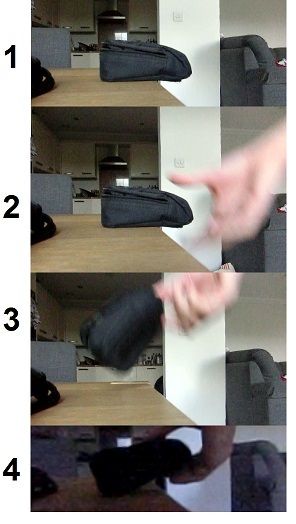autogyro wrote:Engine torque cannot be delivered to the rear wheels through two gears at once.
The aim of the seamless shift is to smoothly transfer drive from one ratio to the next, not specifically to drive both gears at the same time... so that positive force is always applied to the drive train so that there is no deceleration (due to aerodynamic drag) between gearshifts.
How is that possible? Actually we all do it everyday in everyday life... Below are a selection of photos I took of me picking up a camera case off the edge of the table:-
Picture 1: The Camera case at rest, sat on the table. Positive upwards force is applied by the table (preventing it falling on the floor).
Picture 2; shows my hand coming in to grab the camera case. This is filmed at 125 frames per second, and you can see that my hand is moving pretty fast (there's a high relatively difference in speed between my hand and the table). The camera case is still supported by the table.
Picture 3: The camera case is now fully in my hand, not supported by the table at all and traveling at the same speed as my hand (otherwise it wouldn't be in my hand).
At no point in those series of 3 photos does the upwards force acting on the camera case decrease (if it did the case would accelerate towards the floor; F=m.A afterall)...
Picture 4: If we use a much faster film speed (1000 frames per second in this case, hence poorer quality), there is a selection of a few frames
where the camera case is both supported by the table and my hand; despite the fact that the table is stationary and my hand is moving rapidly.
Obviously in this small time frame where the camera is supported by both the table and my hand the case must accelerate up to the speed of my hand, and since F still = m.A this means there must be a momentary increase in force on the object... But Xtrac already already explained this:
Phil Roper, principle engineer at Xtrac, explains that it has not proved to be a problem. The total variation of torque [with the seamless shift technology] is actually smaller and can easily be absorbed by the wind up in the drivetrain. The drivers say it is very smooth and actually unsettles the car less in corners
.
Although the table in the photos is "at rest" it is still a valid example as the point here is that there is a relative difference in the speeds of the two things which are applying force to the object during the transfer of load. (In fact: both the table and my hand are travelling through space at some huge speed, and neither is "at rest").

So "the trick" is creating the mechanism that does the load transfer from one gear to the next, and not the actual physics behind the smooth transfer, which you can see is not "magical" or "impossible" at all....

